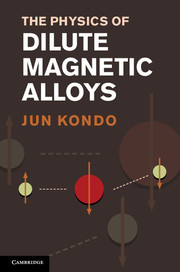3 - The Sommerfeld theory of metals
Published online by Cambridge University Press: 05 March 2013
Summary
Solids are classified according to the qualitative nature of the interaction by which the atoms in solids attract each other. In metals, in particular, there is an important contribution due to the itinerant electrons. We then discuss the Sommerfeld theory, which describes such electrons. Almost all electrons are dormant because of the Fermi-Dirac statistics, and so they do not contribute to either specific heat or susceptibility. Such an electron system is said to be Fermi degenerate, and exhibits a number of singular properties. These are especially marked when the electrons interact with localized spin, and this point will be the main theme of this book in Chapters 5 and beyond.
Classification of solids
Thanks to recent quantum mechanical treatment, thorough understanding has been obtained not only on the problem of why molecular bonds appear but also on the problem of why it is more energetically favorable for atoms to get together and form solids than to be separated into individual atoms and molecules. While some aspects of these problems can be understood to some extent in terms of classical or phenomenological analysis, for the problem of the binding in metals, in particular, a quantum mechanical treatment is indispensable. In this section, let us classify solids on the basis of their condensation mechanism.
Molecular crystals
Since rare-gas atoms such as He, Ne and so on, which have closed-shell structures, and also molecules such as H2, Cl2 and so on, do not interact strongly with one another, it is difficult for them to form solids.
- Type
- Chapter
- Information
- The Physics of Dilute Magnetic Alloys , pp. 32 - 48Publisher: Cambridge University PressPrint publication year: 2012



